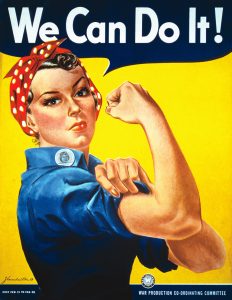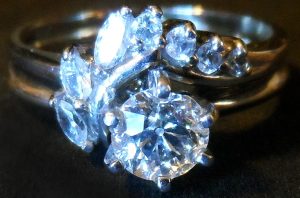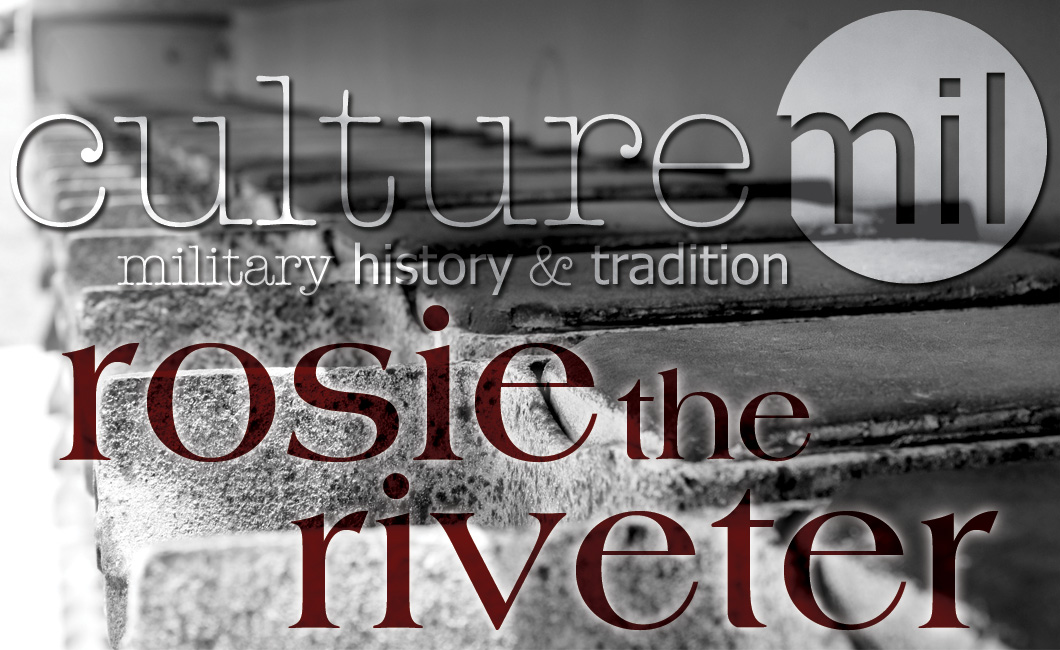- history.com/topics/world-war-ii/american-women-in-world-war-ii
- http://www.history.org/history/teaching/enewsletter/volume7/images/nov/women_military_timeline.pdf
- http://www.nationalww2museum.org/learn/education/for-students/ww2-history/ww2-by-the-numbers/us-military.html?
- statisticbrain.com/world-war-ii-statistics/
- http://people.com/celebrity/rosie-the-riveter-meet-the-woman-who-inspired-the-iconic-poster/
- http://www.u-s-history.com/pages/h1656.html
- http://www.history.com/topics/world-war-ii/rosie-the-riveter
- http://lyricsplayground.com/alpha/songs/r/rosietheriveter.shtml
- http://ic.galegroup.com/ic/uhic/ReferenceDetailsPage/DocumentToolsPortletWindow?displayGroupName=Reference&u=alli1510&u=alli1510&jsid=cb6d531fd254529130158efd0b8aedd2&p=UHIC&action=2&catId=&documentId=GALE%7CCX3424800081&zid=a1b44ac6ad82744c2d70d916c122c4c9
- http://www.pophistorydig.com/topics/rosie-the-riveter-1941-1945/
- http://www.anb.org/articles/20/20-01920.html
- http://www.histage.com/playdetails.asp?PID=2568
- To hear the “Rosie the Riveter” song, visit https://www.youtube.com/watch?v=D2E613J9m0I.
- Out of the estimated 16 million U.S. Troops who served during World War II, approximately 350,000 were women, serving both home and abroad:
- Women’s Army Corps (WAC): 150,000
- Navy’s Women Accepted for Voluntary Emergency Service (WAVES): 100,000
- Coast Guard Women’s Reserves (SPARS): 10,000
- Marine Corps Women’s Reserve: 23,000
- Army Nurse Corps: 60,000
- Navy Nurse Corps: 14,000
- Women’s Airforce Service Pilots (WASP): 1,074
- To view Norman Rockwell’s Rosie the Riveter, which appeared on the cover of the Saturday Evening Post, May 29, 1943, visit http://www.saturdayeveningpost.com/wp-content/uploads/satevepost/RosieTheRiveter_Rosie.jpg.
Written by Jenifer Chrisman on January 30, 2017.
While other girls attend their favorite cocktail bar
Sipping dry Martinis, munching caviar
There’s a girl who’s really putting them to shame
Rosie is her name
– Song1 by Redd Evans and John Jacob Loe
With the onset of America’s participation in World War II after the attack on Pearl Harbor in 1941, the work force on the home front was quickly diminished as men volunteered (38.8%) or were drafted (61.2%) to aid the war effort overseas. An estimated sixteen million men (and women2) served through 1945, leaving the factories, which were needed to produce the items necessary to fight a war, among the hardest hit with staffing shortages.
Throughout the war, but heavily from 1942 on, the government and industry began recruiting women. With slogans such as, “The more women at work, the sooner we win,” and “Women, you could hasten victory by working and save your man,” women were aggressively targeted throughout a wide variety of campaigns.
Over the course of the war, millions of women left their homes to fill the manpower shortage, building bombs, tanks, planes and a myriad of other items necessary to win the war, as well as working in lumber and steel, unloading freight and operating heavy machinery. They filled in wherever there was a need, increasing the workforce by fifty percent.
But it was an uphill battle. Especially in the beginning, women were seen as too physically inferior to fill many of the jobs. As the male workers became shorter in supply, fields that had never been open to women started opening up. However, women’s average salaries were sixty percent or less than what their male counterparts made. And while many employers still believed women couldn’t do the work of men, it was proven over time that some tasks were better suited to women.
With so many women outside the home, child care centers, many built adjacent to plants, emerged across the country. This allowed even more women to seize the opportunity to earn their own way.
Their hardships didn’t end with the war. Many found themselves out of work to make room for the men returning home. Those who wished to remain often faced harassment, but many persevered, either fighting to retain their position or seeking other employment. And although the number of working women decreased somewhat, it set the stage for the generations to come.

English: "We Can Do It!" poster for Westinghouse, closely associated with Rosie the Riveter, although not a depiction of the cultural icon itself. Model may be Geraldine Doyle (1924-2010) or Naomi Parker.
The character of “Rosie” was first brought to life when Walter Pidgeon (Hollywood star) was touring the Ford Motor Company’s aircraft assembly plant. There he met Rose Will Monroe, who he recommended star in a government film promoting the war. From there, Norman Rockwell illustrated the “Rosie” image, which appeared on the cover of the May 29, 1943, issue of the Saturday Evening Post3. J. Howard Miller’s 1943 Rosie the Riveter poster, originally attributed to Geraldine Hoff Doyle from a 1942 photograph taken at Naval Air Station in Alameda, CA, may have actually been inspired by Naomi Parker-Fraley. The two women bore a striking resemblance to one another. Rose Hicker, another real life “Rosie,” appeared in stories after she and her partner, employed at the Eastern Aircraft Company, drove a record number of rivets into the wing of an “Avenger” Bomber at Grumman in Tarrytown, NY.
But “Rosie” wasn’t just a face for media publications. The “Rosie the Riveter” song (1942), written by Redd Evans and John Jacob Loeb, was often used in promotional films that encouraged viewers to buy War Bonds. She also was featured in several movies, including Swing Shift Maisie (1943), Meet the People (1944), Since You Went Away (1944) and Rosie the Riveter (1944), a romantic wartime comedy, as well as Broadway plays, including Rosie the Riveter (1942) and the memoir, Shipyard Diary of a Woman Welder (1944).
Across the nation, both real and iconic, “Rosie” became part of American culture and folklore. She, and all the women who inspired her, changed the face of the nation.
Authors note:
My grandmother’s best friend Marg, my second grandmother, was a “Rosie the Riveter.” Marg watched me grow up and despite the nearly unbridgeable age gap we started to become friends as I entered adulthood. That time, which could have been so much more, was cut short when I moved away in my early twenties. And although I kept in touch by phone, due to the many miles between us I was never able to really get to know her as the amazing person she was.
I was the one who received the call, and had to tell my grandmother, when Marg was finally called home. She lost her second battle with cancer and was survived only by her nephew and his wife.

The large diamond was Marg’s. To the right of the prong facing up the chip from her time at Grumman’s can be seen. Looking closely at the center of the diamond where there is a small glare (dot) of light, the extra facet, typical of a European cut diamond, can be detected. The additional band was added by my mother after Marg passed the ring on to her.
I learned, only in recent years, after my mother passed on Marg’s engagement ring to me (from her second husband), that she found the courage to walk away from her first marriage after her first husband beat her so brutally he left her barren. Harry, who she married in the 1940s, was the love of her life and she never chose to be with another after he passed on when my mother was still young.
Marg not only stepped up to help fill the gap left behind by all the men going off to war, she faced a terrible adversity and made a better life for herself.
The diamond in the ring is chipped from her time at Grumman. A machine caught the ring rather than her hand. Chipped, but unbroken, it symbolizes, to me, both an indomitable will and a love so powerful nothing could crush it.
To Marg and all the “Rosie the Riveters:” This country was not only built on the backs of the men (and women2) who shouldered the responsibly and went off to war, but the women who stepped outside their homes to keep this country running.
Sources:
Notes:




